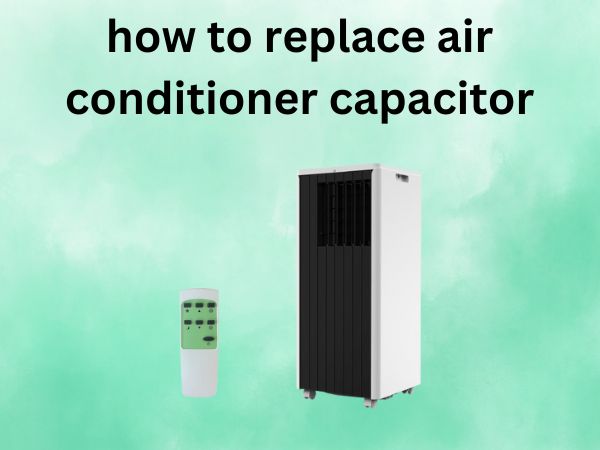How to Replace Air Conditioner Capacitor [A Step-by-Step Guide for Homeowners]
When your air conditioner starts acting up on a sweltering summer day, there’s nothing more frustrating than realizing it might be a capacitor problem. Don’t worry though – replacing an AC capacitor is one of those DIY tasks that sounds intimidating but is actually quite manageable with the right guidance. Think of it like changing a car battery; once you know the steps, it becomes second nature.
Table of Contents
What is an Air Conditioner Capacitor?
An air conditioner capacitor is essentially the “starter” for your AC unit’s motors. Just like how you need a good push to get a heavy door moving, your AC’s compressor and fan motors need that initial electrical boost to kick into action. Without a functioning capacitor, your air conditioner would be like a car trying to start without a battery – it simply won’t work.
Understanding the Role of Capacitors in AC Systems
Capacitors store electrical energy and release it in short bursts to help motors start up and keep running efficiently. They’re like the energy drink for your AC system, providing that extra jolt needed to overcome the initial resistance when motors begin spinning. In your air conditioning system, capacitors work behind the scenes to ensure smooth operation of both the outdoor condenser fan and the compressor.
The capacitor’s job doesn’t end once the motor starts running. It continues to provide power assistance throughout the motor’s operation, helping maintain consistent performance and preventing unnecessary strain on the electrical components. This ongoing support is crucial for the longevity and efficiency of your entire AC system.
Types of AC Capacitors
Your air conditioner typically uses two main types of capacitors: start capacitors and run capacitors. Start capacitors provide the initial power surge needed to get motors spinning, while run capacitors continue supplying power throughout operation. Many modern systems use dual run capacitors, which combine both functions in a single unit – it’s like having a Swiss Army knife instead of separate tools.
Start capacitors are usually larger and have higher capacitance values, designed to deliver a powerful initial boost. Run capacitors are smaller and provide steady, continuous power support. Understanding which type your system uses is crucial for selecting the correct replacement part.
Signs Your Air Conditioner Capacitor Needs Replacement
Recognizing the warning signs of a failing capacitor can save you from a complete system breakdown during peak cooling season. These components don’t usually fail suddenly; they typically give you plenty of warning signals if you know what to look for.
Visual Inspection Warning Signs
The most obvious signs of capacitor failure are visible to the naked eye. A bulging or swollen capacitor top is a dead giveaway – it should be flat, not dome-shaped like a miniature hill. You might also notice brown or black burn marks, oil leakage around the base, or corrosion on the terminals. These visual cues are your capacitor’s way of waving a white flag.
Rust or corrosion around the capacitor housing is another red flag. When moisture gets into the electrical components, it accelerates deterioration and can cause premature failure. If you see any white, chalky residue or greenish corrosion, it’s time to start planning for a replacement.
Performance-Related Symptoms
Your AC system will often tell you when the capacitor is struggling through its performance. If your air conditioner takes longer than usual to start up, makes unusual humming or clicking noises, or seems to struggle to maintain consistent cooling, the capacitor might be the culprit. It’s like when your car takes multiple attempts to start – something’s not getting the power it needs.
Another telltale sign is when your outdoor unit’s fan isn’t spinning, but you can hear the compressor trying to run. This often indicates a fan motor capacitor failure. Similarly, if your system starts but then shuts off quickly, or if it runs but doesn’t cool effectively, capacitor issues could be to blame.
Electrical Testing Indicators
While visual inspection and performance symptoms can give you strong clues, electrical testing provides definitive answers. Using a multimeter to test capacitance values will tell you exactly whether your capacitor is within acceptable parameters. A capacitor that tests significantly below its rated value needs replacement, even if it looks fine externally.
Higher than normal electrical bills can also indicate capacitor problems. When capacitors aren’t functioning properly, motors work harder and draw more current, leading to increased energy consumption. It’s like driving with the parking brake partially engaged – everything still works, but it’s inefficient and costly.
Safety Precautions Before Starting
Working with electrical components always requires respect for safety protocols. Capacitors can store electrical charge even when power is disconnected, making them potentially dangerous if handled improperly. Think of them as electrical time bombs that need to be defused carefully.
Essential Safety Equipment
Before you even think about touching that capacitor, gather your safety gear. Insulated gloves are non-negotiable – they’re your first line of defense against electrical shock. Safety glasses protect your eyes from potential debris or sparks, and non-conductive tools help prevent accidental short circuits.
A voltage tester or multimeter is essential for confirming that power is truly off and that the capacitor has discharged its stored energy. Never assume a capacitor is safe to handle just because the power is off – always test first. It’s better to be overly cautious than to learn about stored electrical charge the hard way.
Power Disconnection Procedures
Start by turning off your air conditioner at the thermostat, then locate and switch off the electrical disconnect near your outdoor unit. For extra safety, also turn off the circuit breaker at your main electrical panel. This multi-step process ensures power is completely isolated from your AC system.
After disconnecting power, wait at least 30 minutes before proceeding. This waiting period allows any stored charge in the capacitor to dissipate naturally. Even then, use an insulated screwdriver to short the capacitor terminals together, ensuring complete discharge before handling.
Tools and Materials You’ll Need
Having the right tools makes this job much easier and safer. You don’t need a professional electrician’s toolkit, but having quality basic tools will make the difference between a smooth repair and a frustrating struggle.
Basic Tools Required
Your tool list should include a screwdriver set with both Phillips and flathead drivers, needle-nose pliers for handling wires, and a nut driver set for removing panels and components. A digital multimeter is invaluable for testing both the old and new capacitors, and a camera or smartphone helps document wire connections before removal.
Wire strippers might be necessary if you need to prepare new wire ends, and electrical tape ensures secure connections. A flashlight or headlamp provides good visibility in tight spaces, and having a small container for screws prevents losing important hardware during the repair process.
Choosing the Right Replacement Capacitor
Selecting the correct replacement capacitor is crucial for proper operation and safety. The capacitor label contains vital information including voltage rating, capacitance value (measured in microfarads or μF), and physical dimensions. These specifications must match your original capacitor exactly – it’s like buying the right size battery for your remote control.
Pay attention to the voltage rating, which should match or exceed the original. Using a capacitor with lower voltage rating can lead to immediate failure and potential damage to your AC system. The capacitance value should also match exactly, as too high or too low can affect motor performance and efficiency.
Step-by-Step Capacitor Replacement Process
Now comes the main event – actually replacing that capacitor. Take your time with each step, and don’t rush. This isn’t a race, and careful attention to detail will ensure a successful repair that lasts for years.
Accessing the Capacitor
Start by removing the access panel on your outdoor AC unit. This usually involves removing several screws or clips around the panel’s perimeter. Keep track of all hardware – you’ll need it for reassembly. Once the panel is off, locate the capacitor, which typically looks like a metal cylinder with wires connected to the top.
Take photos of the wiring connections before disturbing anything. These reference photos are invaluable when it’s time to connect the new capacitor, especially if you get interrupted during the repair. Label each wire with masking tape if necessary, noting which terminal it connects to.
Safely Removing the Old Capacitor
Before touching anything, use your voltage tester to confirm the capacitor is discharged. Even with power off, capacitors can hold dangerous voltage levels. Once you’ve confirmed it’s safe, carefully disconnect the wires from the capacitor terminals. Some connections use spade terminals that slide off, while others might have screw terminals.
Remove the capacitor’s mounting bracket or strap, being careful not to drop the old capacitor. These components are heavier than they look and can cause injury if dropped on your foot. Handle the old capacitor with respect – it may contain oil or other substances that you don’t want on your skin.
Installing the New Capacitor
Position the new capacitor in the same location as the old one, securing it with the original mounting hardware. Make sure it’s oriented correctly – the terminals should be in the same position as the original. Connect the wires to their respective terminals, referring to your reference photos to ensure correct placement.
Tighten terminal connections firmly but don’t over-tighten, which can damage the threads or terminals. Each wire should have a secure connection without any exposed copper visible. If wire ends are corroded or damaged, trim them back and strip fresh copper for better connections.
Testing Your Work
Before reassembling everything, it’s time for the moment of truth. Replace the access panel temporarily and restore power to your AC system. Turn on your air conditioner and observe its operation. The system should start smoothly without unusual noises or hesitation.
Watch for proper fan operation and listen for normal compressor sounds. If everything appears to be working correctly, let the system run for 10-15 minutes to ensure stable operation. Any unusual sounds, failure to start, or other problems indicate you should double-check your connections and installation.
Common Mistakes to Avoid
Even experienced DIYers can make mistakes that turn a simple repair into a costly problem. Learning from others’ mistakes is much cheaper than making them yourself, so let’s cover the most common pitfalls to avoid.
The biggest mistake is using the wrong capacitor specifications. It might seem like a close match is good enough, but electrical components require exact specifications for safe operation. Using incorrect voltage or capacitance values can damage your AC system or create safety hazards.
Another common error is failing to properly discharge the capacitor before handling it. Even with power off, capacitors can deliver a painful and potentially dangerous shock. Always test and discharge capacitors before touching them, even if you’re confident the power is off.
Poor wire connections cause many callbacks for professional technicians. Loose connections create heat and can lead to system failure or fire hazards. Make sure all connections are tight and secure, with no exposed copper visible at terminal points.
When to Call a Professional
While capacitor replacement is generally a straightforward DIY task, certain situations warrant professional attention. If you’re uncomfortable working with electrical components, don’t push yourself – electrical work isn’t worth risking your safety over.
Call a professional if you discover multiple failed components, signs of electrical burning or damage beyond just the capacitor, or if your system still doesn’t work properly after capacitor replacement. These situations often indicate more complex problems that require professional diagnosis and repair.
If your air conditioner is still under warranty, attempting DIY repairs might void that coverage. Check your warranty terms before proceeding, as professional repair might be covered at no cost to you.
Maintenance Tips to Extend Capacitor Life
Prevention is always better than repair, and there are several things you can do to help your capacitors last longer. Regular maintenance doesn’t guarantee they’ll never fail, but it can significantly extend their lifespan and improve overall system reliability.
Keep your outdoor unit clean and free from debris. Grass clippings, leaves, and dirt can block airflow and cause your system to work harder, putting additional stress on electrical components including capacitors. A clean system runs cooler and more efficiently, reducing component wear.
Schedule annual professional maintenance for your AC system. During these visits, technicians can test capacitor values and identify components that are beginning to fail before they cause system shutdowns. Early detection allows for planned replacement rather than emergency repairs during peak cooling season.
Avoid short cycling your air conditioner by setting appropriate thermostat temperatures and using programmable schedules. Frequent starting and stopping puts extra stress on capacitors and other electrical components. Let your system run in longer cycles for better efficiency and component longevity.
Cost Considerations
Understanding the costs involved helps you make informed decisions about DIY versus professional repair. Capacitor replacement is one of the more cost-effective AC repairs you can tackle yourself, with significant savings compared to service calls.
A replacement capacitor typically costs between $10 and $50, depending on the type and specifications. Professional installation of the same capacitor might cost $150 to $300, including labor and markup. The potential savings make this an attractive DIY project for many homeowners.
However, factor in the cost of tools if you don’t already own them, and consider the value of your time. If you’re already handy with basic electrical work, this project makes sense. If you’re starting from scratch with tool purchases and learning curve, the economics might favor professional service.
Frequently Asked Questions
Q: How long does an air conditioner capacitor typically last? A: Most AC capacitors last between 10-20 years, depending on usage, environmental conditions, and system maintenance. Extreme temperatures, frequent cycling, and electrical surges can shorten their lifespan significantly.
Q: Can I use a higher voltage capacitor than what was originally installed? A: Yes, you can use a capacitor with a higher voltage rating than the original, but never lower. The capacitance value (microfarads) should match exactly. Higher voltage rating provides additional safety margin but doesn’t affect performance.
Q: What happens if I install the wires on the wrong terminals? A: Incorrect wiring can prevent your AC system from starting, cause motors to run backwards, or potentially damage electrical components. Always take reference photos before disconnecting wires and follow them carefully during installation.
Q: Is it normal for a new capacitor to be warm during operation? A: Yes, capacitors generate some heat during normal operation, but they shouldn’t be too hot to touch. Excessive heat could indicate incorrect installation, wrong specifications, or other system problems that need attention.
Q: How can I tell if my capacitor problem is actually something else? A: If replacing the capacitor doesn’t resolve your AC problems, issues might include failed contactors, bad motors, refrigerant problems, or control board failures. These situations typically require professional diagnosis and repair.
Conclusion
Replacing an air conditioner capacitor is one of those home maintenance tasks that initially seems daunting but becomes routine once you understand the process. With proper safety precautions, the right tools, and careful attention to detail, most homeowners can successfully complete this repair and save significant money compared to professional service calls.
Remember that safety should always be your top priority when working with electrical components. Take your time, follow proper procedures, and don’t hesitate to call a professional if you encounter unexpected complications or feel uncomfortable at any point during the process.
The satisfaction of successfully repairing your own air conditioner, combined with the money saved and knowledge gained, makes this a worthwhile skill for any homeowner. Plus, you’ll have the confidence to tackle similar repairs in the future, making you more self-sufficient in maintaining your home’s comfort systems.




